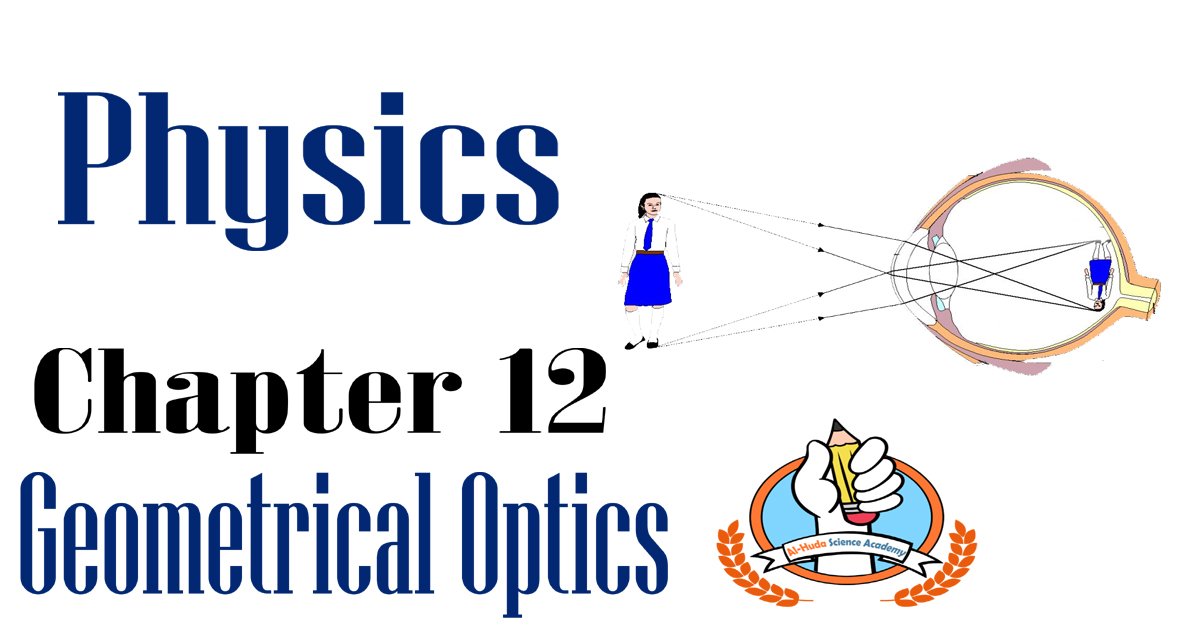Review Questions for Physics Class 10 Chapter 12 Geometrical Optics
12.1. What do you understand by reflection of light? Draw a diagram to illustrate reflection at a plane surface.
Ans. When light travelling in a certain medium fall on the surface of another medium, a part of it turns back in the same medium.
Regular Reflection is formed from plane or smooth surface.

12.2. Describe the following terms used in reflection:
(i) normal (ii) angle of incidence (iii) angle of reflection
Ans. Normal: The perpendicular to a reflecting or refracting surface at the point of incidence of the ray concerned is call normal.
Angle of Incidence: The angle between the incident ray and the normal is called angle of incidence.
Angle of reflection: The angle between the normal and the reflected ray is called angle of reflection.
12.3. State laws of reflection. Describe how they can be verified graphically.
Ans. (i) The incident ray, the normal, and the reflected ray at the point of incidence all lie in the same plane.
(ii) The angle of incidence is equal to the angle of reflection i.e., i = r.
Graphical verification of laws of reflection
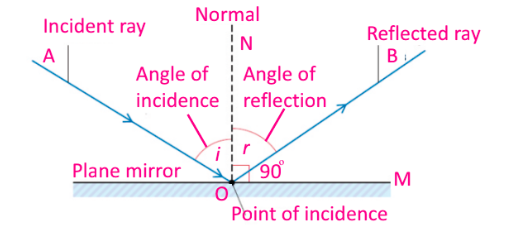
12.4. Define refraction of light. Describe the passage of light through parallel-sided transparent material.
Ans. The bending of light as it passes from one transparent medium into another is called refraction of light.
Refraction of light can be explained with the help of figure. A ray of light IO travelling from air falls on the surface of a glass block.
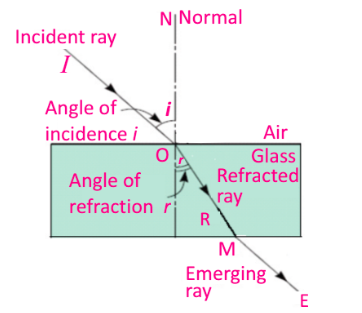
12.5. Define the following terms used in refraction:
(i) angle of incidence (ii) angle of refraction
Ans. Angle of Incidence: The angle between the incident ray and the normal is called angle of incidence.
Angle of refraction: The angle between the normal and the refracted ray is called angle of reflection.
12.6. What is meant by refractive index of a material? How would you determine the refractive index of a rectangular glass slab?
Ans. The refractive index ‘n’ of a medium is the ratio of the speed of light ‘c’ in air to the speed ‘v’ of light in the medium:
Refractive Index = Speed of light in air / Speed of light in medium
The refractive index of a rectangular slab can be found using formula n = c/v
12.7. State the laws of refraction of light and show how they may be verified using rectangular glass slab and pins.
Ans. (i) The incident ray, the normal, and the refracted ray at the point of incidence all lie in the same plane.
(ii) The angle of incidence is equal to the angle of refraction i.e., sin i / sin r = constant = n
where the ratio sin i / sin r is known as the refractive index of the second medium with respect to the first medium. So,
we have sin i /sin r = n
It is called Snell’s law.
12.8. What is meant by the term total internal reflection?
Ans. The angle of incidence for which the angle of refraction becomes 90 is called critical angle. When the angle of incidence becomes larger than the critical angle, no refraction occurs. The entire light is reflected back into the denser medium. This is known as total internal reflection of light.
12.9. State the conditions for total internal reflection.
Ans.

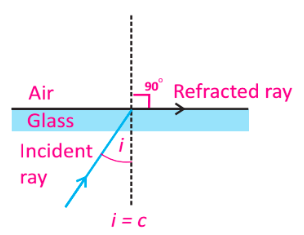
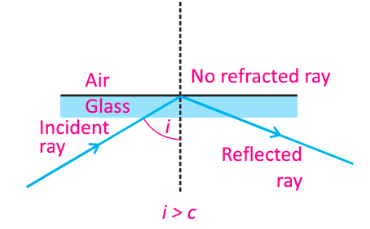
12.10. What is critical angle? Derive a relationship between the critical angle and the refractive index of a substance.
Ans. The angle of incidence, that causes the refracted ray in the rarer medium to bend through 90o is called critical angle.
sin i / sin r = n
sin i = n sin r
i = sin-1(n sin r)
12.11. What are optical fibres? Describe how total internal reflection is used in light propagating through optical fibres.
Ans. Total internal reflection is used in fibre optics which has number of advantages in telecommunication field. Fibre optics consists of hair size threads of glass or plastic through which light can be travelled.
Light entering from one end of the core strikes the core-cladding boundary at an angle of incidence greater than critical angle and is reflected back into the core. In this way light travels many kilometres with small loss of energy.
12.12. Define the following terms applied to a lens:
(i) principal axis (ii) optical centre (iii) focal length
Ans. Principal Axis: Axis: Each of the two surfaces of a spherical lens is a section of a sphere. The line passing through the two centres of curvatures of the lens is called principal axis.
Optical Centre: A point on the principal axis at the centre of lens is called optical centre.
Focal Length: This is the distance between the optical centre and the principal focus.
12.13. What is meant by the principal focus of a (a) convex lens (b) concave lens? Illustrate your answer with ray diagrams.
Ans. Convex Lens: The lens which causes incident parallel rays to converge at a point is known as convex or converging lens.

Concave Lens: The lens which causes the parallel rays of light to diverge from a point. This is called concave or diverging lens.

12.14. Describe how light is refracted through convex lens.
Ans. Convex lenses refract light inward toward a focal point. Light rays passing through the edges of a convex lens are bent most, whereas light passing through the lens’s center remain straight. Convex lenses are used to correct farsighted vision.
Convex lenses are the only lenses that can form real images.
12.15. With the help of a ray diagram, how you can show the use of thin converging lens as a magnifying glass.
Ans. A converging lens becomes a magnifying glass when an object is located inside the lens’s focal length.

12.16. A coin is placed at a focal point of a converging lens. Is an image formed? What is its
nature?
Ans. When the coin I placed at the focal point of the principal focus, no image is formed. Because the refracted rays are parallel and never meet.
12.17. What are the differences between real and virtual images?
Ans.
| Real Image | Virtual Image |
| It is formed by concave mirror only. | It can be formed by concave and convex mirror. |
| It is always inverted. | It is always erect. |
| It is formed at real principal focus of a real object i.e.; light rays actually pass the angle of principal focus. | It is formed at virtual principal focus of a virtual object i.e.; light rays appear to be diverged from principal focus. |
| It has positive sign convention. | It has negative sign convention. |
| It is formed in front of mirror. | It is formed behind of mirror. |
| Focal length of real image is taken as positive. | Focal length of virtual image is taken as negative. |
12.18. How does a converging lens form a virtual image of a real object? How does a diverging lens can form a real image of a real object?
Ans. When the object is placed between the convex lens and principal focus (F), the image will be virtual.

A concave lens cannot form a real image of a real object in the air. If the concave lens is placed in a medium of refractive index greater than that of glass, then it will form real image of a real object.
12.19. Define power of a lens and its units.
Ans. Power of a lens is defined as the reciprocal of its focal length in metres. Thus
Power of a lens = P = 1 / focal length in metres
Unit of power of lens is:
The SI unit of power of a lens is “Dioptre”, denoted by a symbol D. If f is expressed in metres so that 1 D = 1 m-1.
12.20. Describe the passage of light through a glass prism and measure the angle of deviation.
Ans. As the light enters the first refracting surface of the prism it gets refracted and is incident at the second refracting surface and emerges out at an angle of emergence from the prism. The angle of deviation of is the angle of diversion which is produced in the path of the incident light ray striking at the prism.

12.21. Define the terms resolving power and magnifying power.
Ans. Resolving Power: The resolving power of an instrument is its ability to distinguish between two closely placed objects or point sources.
Magnifying Power: The magnifying power, or extent to which the object being viewed appears enlarged, and the field of view, or size of the object that can be viewed, are related by the geometry of the optical system.
12.22. Draw the ray diagrams of
(i) simple microscope (ii) compound microscope (iii) refracting telescope
Ans. Simple Microscope
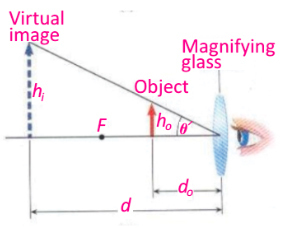
Compound Microscope
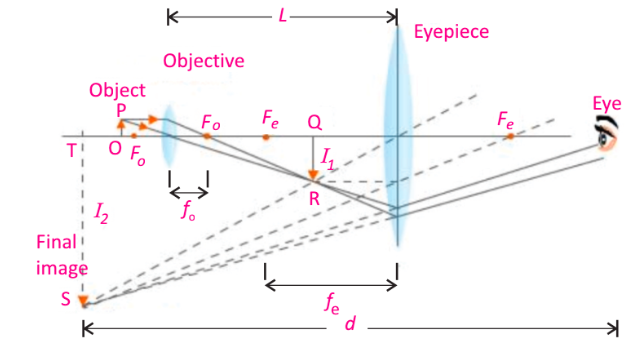
Refracting Telescope

12.23. Mention the magnifying powers of the following optical instruments:
(i) simple microscope (ii) compound microscope (iii) refracting telescope
Ans.
- The magnifying power of a simple microscope can be found using: M = 1+d/f
- The magnifying power of compound microscope can be found using: M = L/fo (1+d/fe)
- The magnifying power of refracting telescope can be found using: M = f/fe
12.24. Draw ray diagrams to show the formation of images in the normal human eye.
Ans.

12.25. What is meant by the terms nearsightedness and farsightedness? How can these defects be corrected?
Ans.
Nearsightedness
The disability of the eye to form distinct images of distant objects on its retina is known as nearsightedness.
Correction
The nearsighted eye can be corrected with glass or contact lenses that use diverging lenses. Light rays from the distant objects will diverge by this lens before entering the eye.
Farsightedness
The disability of the eye to form distinct images of nearby objects on its retina is known as farsightedness.
Correction
This defect can be corrected with the aid of a suitable converging lens. The lens refracts the light rays more towards the principal axis before they enter the eye.
Conceptual Questions for Physics Class 10 Chapter 12 Geometrical Optics
12.1. A man raises his left hand in a plane mirror, the image facing him is raising his right hand. Explain why?
Ans. A man raises his left hand in a plane mirror; the image facing him is raising his right hand. Because light rays are reflected in a mirror causing us to see an inverted image.
12.2. In your own words, explain why light waves are refracted at a boundary between two materials.
Ans. Light rays are reflected at a boundary between two materials due to changes in the speed of light while traveling from one medium to another. This change of speed of light at the boundary is caused by the change in the refractive indices of the two materials.
12.3. Explain why a fish under water appears to be at a different depth below the surface than it actually is. Does it appear deeper or shallower?
Ans.

A fish underwater appears to be shallower than it really is, because of apparent depth, as a virtual image is formed at I above O, where the image seems to be formed due to refraction of light.
12.4. Why or why not concave mirrors are suitable for makeup?
Ans. Concave mirrors are suitable for mirrors for makeup as they act as magnifiers to form large size erect images of objects when a person stands between the principal focus and the pole of the mirror.
12.5. Why is the driver’s side mirror in many cars convex rather than plane or concave?
Ans. The driver’s side mirror is a convex mirror as it gives an upright, erect although small image, it provides a wider field of view as it is curved outwards.
12.6. When an optician’s testing room is small, he uses a mirror to help him test the eyesight of his patients. Explain why?
Ans. To increase the distance of alphabets from the patient, the optician uses a plane mirror if his testing room is small.
12.7. How does the thickness of a lens affect its focal length?
Ans. If the thickness of the lens is increased, the power of the lens is also increased. Hence the focal length of the lens is decreased.
12.8. Under what conditions will a converging lens form a virtual image?
Ans. A converging lens forms a virtual image when the object is placed between the optical center and its focal point. The image formed will be erect and larger than an object.
12.9. Under what conditions will a converging lens form a real image that is the same size as the object?
Ans. When the object is placed at 2F from the converging lens it forms a real and inverted image that has the same size as the object.
12.10. Why do we use refracting telescope with large objective lens of large focal length?
Ans. In refracting telescopes, we use an objective lens of a larger focal length so as to gather more light from weak distant sources. It not only makes them visible but also increases the resolving power of the telescope.

